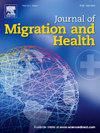在美国的时间和加州黑人的身体活动:来自加州健康访谈调查(2012-2017)的发现
IF 2.9
Q1 PUBLIC, ENVIRONMENTAL & OCCUPATIONAL HEALTH
引用次数: 0
摘要
背景:在加州的外国出生的黑人中,没有研究调查文化适应与体育活动(PA)之间的关系,尽管黑人的PA率较低,但较低的PA率有患心血管疾病的风险,而且这一人口正在增长。此外,尽管CVD和PA在性别和心理健康状况方面存在差异;没有研究检验这些因素是否改变了文化适应和PA之间的联系。方法我们使用加州健康访谈调查(2012-2017)和完全调整的调查加权回归模型来检验在美国的时间作为文化适应的代理(即外国出生在美国≥10年,外国出生在美国≥10年)与加州黑人(n = 5,952)中步行的PA[休闲时间(LTPA)和交通相关(TRPA)]之间的关系。我们还测试了性别和心理健康状况对效果的影响。结果样本中约7%为外国出生。在调整后的TRPA模型中,在美国生活10年的外国出生组中,行走PA的几率明显更高(OR = 8.63;95% ci: 2.49, 29.86;p & lt;0.01),在美国生活≥10年的外国出生组无差异(OR = 1.05;95% ci: 0.62, 1.75;p = 0.85),与美国出生的加州黑人相比。我们发现,除了抑郁的频率外,性别或心理健康状况对这种联系没有影响。结论:与美国出生的黑人相比,一些外国出生的加州黑人在交通相关的PA中步行的几率更高。未来的研究需要检验心理健康状况对移民群体PA水平的作用。本文章由计算机程序翻译,如有差异,请以英文原文为准。
Time in the United States and walking for physical activity among Black Californians: Findings from the California Health Interview Survey (2012–2017)
Background
No studies examine associations between acculturation and physical activity (PA) in California's foreign-born Black population, even though rates of PA are lower in Black populations, lower PA rates are a risk for cardiovascular disease, and this population is growing. Further, despite differences in CVD and PA by sex and mental health status; no studies have examined whether these factors modify associations between acculturation and PA.
Methods
We used the California Health Interview Survey (2012–2017) and fully adjusted, survey-weighted regression models to examine associations between time in the US as a proxy for acculturation (i.e., foreign-born <10 years in the US, foreign-born ≥10 years in the US) and walking for PA [leisure time (LTPA) and transportation-related (TRPA)] among Black Californians (n = 5,952). We also tested effect modification by sex and mental health status.
Results
About 7 % in the sample were foreign-born. In the adjusted model of TRPA, the odds of walking for PA were significantly higher in the foreign-born group living <10 years in the US (OR = 8.63; 95 %CI: 2.49, 29.86; p < 0.01) and no different in the foreign-born group living ≥10 years in the US (OR = 1.05; 95 % CI: 0.62, 1.75; p = 0.85), compared to US-born Black Californians. We found no effect modification of the associations by sex or mental health, except by frequency of feeling depressed.
Conclusion
Some foreign-born Black Californians have higher odds of walking for PA related to transportation than their US-born counterparts. Future research is needed to examine the role of mental health status on PA levels of this immigrant group.
求助全文
通过发布文献求助,成功后即可免费获取论文全文。
去求助
来源期刊

Journal of Migration and Health
Social Sciences-Sociology and Political Science
CiteScore
5.70
自引率
8.70%
发文量
65
审稿时长
153 days
 求助内容:
求助内容: 应助结果提醒方式:
应助结果提醒方式:


